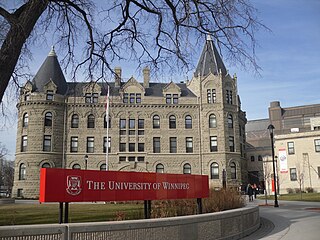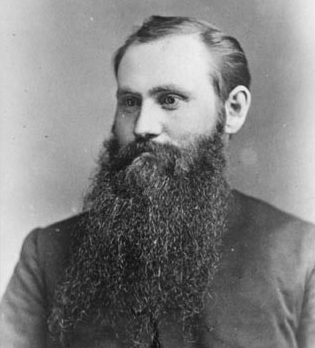
The University of Manitoba is a public research university in Winnipeg City, Manitoba Province, Canada. Founded in 1877, it is the first university of Western Canada. Both by total student enrolment and campus area, the University of Manitoba is the largest university in the province of Manitoba. Its main campus is located in the Fort Garry neighbourhood of Winnipeg, with other campuses throughout the city: the Bannatyne Campus, the James W. Burns Executive Education Centre, the William Norrie Centre, and the French-language affiliate, Université de Saint-Boniface in the Saint Boniface ward.

Robert Machray was an Anglican bishop and missionary and the first Primate of the Church of England in Canada.
Manitoba College was a college that existed in Winnipeg, Manitoba, Canada, from 1871 to 1967, when it became one of the University of Winnipeg and University of Manitoba’s founding colleges. It was one of the first institutions of higher learning in the city of Winnipeg and the province of Manitoba. The first graduating class had 12 members.

St. Paul's College is a Roman Catholic College on the Fort Garry campus of the University of Manitoba in Winnipeg, Mantioba, Canada. It was founded in 1926 by the Oblate Fathers, and became affiliated with the University of Manitoba in 1931. It is the only Catholic higher education institute in the province.
The Opaskwayak Cree Nation is a First Nations band government located in Manitoba, Canada. The main OCN reserve is regarded as one of three distinct communities that comprise "The Pas area" in northern Manitoba, with the two others being the Town of The Pas and the Rural Municipality of Kelsey.

Wesley College was a college that existed in Winnipeg, Manitoba, Canada, from 1888 to 1938. In 1924, Wesley College became part of the United Church of Canada. It was one of the University of Winnipeg's founding colleges.

Huron University College is a university college affiliated with the University of Western Ontario in London, Ontario, Canada. It was Incorporated on the 5 May 1863. Huron is the founding institution of the University of Western Ontario.

Wycliffe College is an evangelical graduate school of theology at the University of Toronto. Founded in 1877 as an evangelical seminary in the Anglican tradition, Wycliffe College today attracts students from many Christian denominations from around the world. As a founding member of the Toronto School of Theology, students can avail themselves of the wide range of courses from Canada's largest ecumenical consortium. Wycliffe College trains those pursuing ministry in the church and in the world, as well as those preparing for academic careers of scholarship and teaching.

Providence University College and Theological Seminary is an interdenominational Evangelical Christian university college and theological seminary located approximately 50 kilometres southeast of Winnipeg in Otterburne, Manitoba.

The Diocese of Rupert's Land is a diocese of the Ecclesiastical Province of Rupert's Land of the Anglican Church of Canada. It is named for the historical British North American territory of Rupert's Land, which was contained within the original diocesan boundaries.

St. John's Cathedral is an Anglican cathedral in Winnipeg, Manitoba, Canada, which is the cathedral church of the Diocese of Rupert's Land. It is located in the Luxton neighbourhood of north-end Winnipeg on Anderson Avenue near Main Street and the Red River. St. John's Cathedral marks the birthplace of the Anglican Church in western Canada.

Samuel Pritchard Matheson was a Canadian clergyman, Archbishop of Rupert's Land, and fourth, as well as the longest-serving, Primate of the Anglican Church of Canada.
John Grisdale was an Anglican colonial bishop in the late 19th century.
Duncan Douglas Wallace was the 10th Bishop of Qu'Appelle in the Anglican Church of Canada.
Thomas William Ralph Collings, known as Tom Collings, was a British-born Canadian Anglican bishop. He served as the seventh Bishop of Keewatin from 1991 to 1996.
Walter Heath Jones was an Anglican bishop in the United States and Canada.
Barry Valentine was bishop of the Diocese of Rupert's Land in the Anglican Church of Canada from 1970 to 1982. Valentine's episcopacy was "transformational and visionary."
Harry Martindale Speechly was a Canadian medical doctor.
Robert McDonald was an Anglican missionary among First Nation peoples in Canada, particularly in the northwest Arctic.
Helen Jane Kennedy is a bishop of the Anglican Church of Canada. She is the current bishop of the Diocese of Qu'Appelle in southern Saskatchewan.










